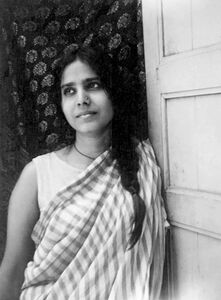Kanika di came into my life via a visit to Dr. Amiya Deb’s home at Jatin Das Road. My friend, Neelanjana Sarkar who then studied Comparative Literature at Jadavpur University tagged me along in one of her visit and I came to meet Kanika di. I remember her for the care and attention she lavished on all whom she knew. She had time for everyone; she enjoyed talking through ideas and she made one feel part of a team of intelligentsia.
Later we came close as I worked in an Advertising Agency, Redifussion, quartered at Russell Street and she was working in CMDA (Calcutta Metropolitan Development Authority) having there office at Auckland Place. We met for lunch nearby at Jimmy’s Kitchen, a quaint Chinese Restaurant serving good Chinese food. She called me a Tansh ( ট্যাঁশ ) a loose term for Anglo Indian having a disregard for their mother tongue, giving importance to English, as I had less knowledge of the Bengali Literature and chided me to the rich world of Bengali Literature. World of Tagore, Buddhadev Bose and others. She would read out Bengali poems and mostly recited by heart. Once an Advertisement appeared in Anandabazar Patrika of my client Red Eveready. Kanika di rang me up to point out a mistake in the Bengali body copy . I immediately brought it to the attention of my seniors and the release was immediately suspended. The correction made for the next round. My colleagues were very impressed because it was in a finer nuance and the Account Executive Rajiv Agarwal wanted to meet her. He did and for some reason it went round in my office that we; Kanika di and myself are brother and sister.
Kanika di was warm-hearted, frothy wit, ebullient fantasy and an expansive cast of unusual and fascinating being. Her life appeared to be effortlessly spun in the finest thread from an endless source of imagination. Descriptively vivid, richly inventive and shot through with perfectly timed wit, which charmed all who came in contact with her.
It is during this time that she started a Single Person play. Her Single Personae dramatic act was praised it for being a bit like reading yourself. It was a real pleasure listening to her read aloud because the voice was great and she threw very savoury and knowing titbits of irony. A perfectionist herself, redrafting her words in her mind many times before achieving exactly what she wanted. Every word she uttered was an improvement of the impromptu past, having raised some punctuation queries herself about the introduction of shorter sentences. Has the semi-colon become a Bad Thing, or a dash? It worried her a lot. I feel like a horse constantly pulled up in mid-gallop with someone tugging at the bit. I do know that short sentences are now the thing but I am a bit old for fashion, she once sighed to me.
I must confess that the first thing I noticed about Kanika di was the unusual dress sense. A small bindi, maybe a black thread around with a pendant and a saree white over black, and splendidly wrinkled. Settled in an armchair in Jatin Das Road home, surrounded by books and photographs and records, her interests stretched far beyond her sartorial state, and it was ever thus. She talked about sitting for the artist Paritosh Sen for a portrait, whose portrait of women in Desh Magazine in a series was then talk of the town and now hangs in the ABP Portrait Gallery. Did the Portrait take place? Or maybe Yes with Kanika di by then losing interest and not making a fuss over it, the kind of person she was.
In Free School Street you had these shops selling old vinyl records, mostly of well-known artists both Hindustani and Western but sometimes you could get a Western Classical like Beethoven or Bach. Having shared this with Kanika di it became a bait as she pestered a visit to these stall and she picked up a couple among them being Johann Sebastian Bach’s Brandenburg Concerto 5 played in Hapsichord which I understand she went on listening till very late in life.
I came to know her well and relished her company when she was working in CMDA. She was the Public Relations Manager of this new entity which would reshape Calcutta infrastructure. The organisation was formed under a Presidential Ordinance in 1970. It works now under provision of the West Bengal Town and Country (Planning & Development) Act, 1979. Its Planning Directorate was set up in 1974. Those were the days when World Bank was funding the Eastern Metropolitan Bypass and the Chief honchos flew in regularly for meetings. It was Kanika di who coordinated these meetings. She was well versed in English. Bengali and Hindi, the last she acquired fluency as she was raised up in Hazaribagh. She was the spokesperson and briefed the Press. Soon after I got an offer to join the Anandabazar Group in a senior position and she was the most happiest of person. My mother was happy, but did not see it the way Kanika di did. She felt it was big time, the post being held previously by doyen of the industry. My office shifted out from the close proximity of Kanika di and with much bigger role to play I lost touch with her. We did meet once in a while which lengthened out and just faded.
She continued to be a sort of icon to many fledging artists, writers and musicians and attracted an enormous amount of affection. She never lost her sharp eye on a world she had seriously helped to change for the better.

